TUTORIAL: CSM Speed Painting by Goatboy


Hi all,
I think its time for a painting article. How about You? Now I know, I know… we are all busy poeple and lead busy productive lives. That said, we all find time to collect that ever growing pile of non-painted GW minis that builds up in our hobby rooms and mocks us day and night.
We all want to have beautiful Golden Daemon quality armies, but really, at the end of the day I just like to get a nice paint scheme that is easy to do and looks good on the tabletop on my minis.
With that in mind, I’ve asked one of BoLS good friends Goatboy to show us what can be done by any one of us, regardless of painting skill level. I gave him a tough assignment. He was to paint up an entire 10-man squad of minis with their dedicated transport in 2 hours. He was to use methods that are easily replicated and look good on the tabletop. He accomplished it with flying colors. I present:
Speed Painting CSMs in 10 Easy Steps!
Goatboy take it away:
Step 1
Paint em black. Cuz that fits for my coloring style and my own choice for doing any kinda of design. Some people prefer white, but I like em painted black first.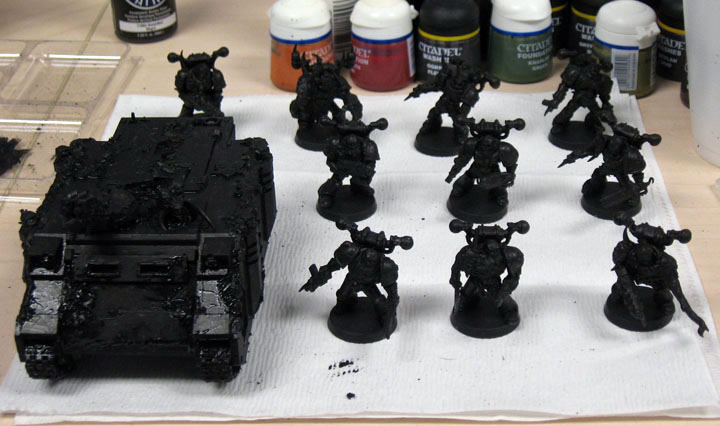
Step 2
Dry brush with foundation color Knarloc Green. I dry brushed it fairly loose and thick in places to give it a nice chunky look. Like bits of flesh and to create more texture on the form.
Step 3
I dry brushed using foundation Gretchin Green to bring up the greens. These initial stages are not meant to be that detail intensive, they are just there to create varying shades of color and small bits of texture due to the amount of paint hitting the model.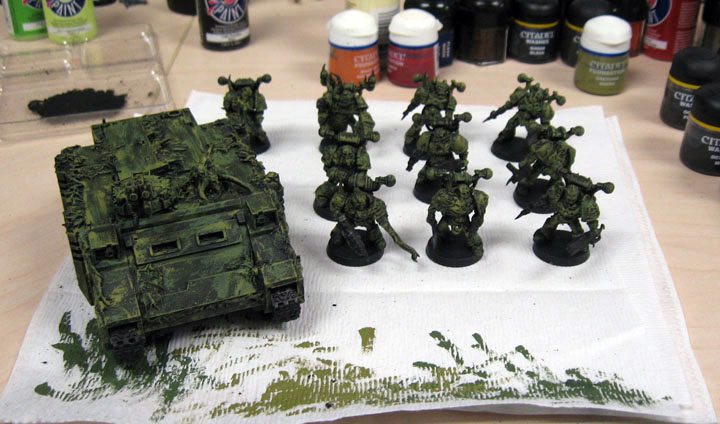
Step 4
I used the new Thraka Green wash on the model, as well as added a layer of bubonic brown to the zombie flesh bits to bring up that color and make it stand out from the rotten old armor.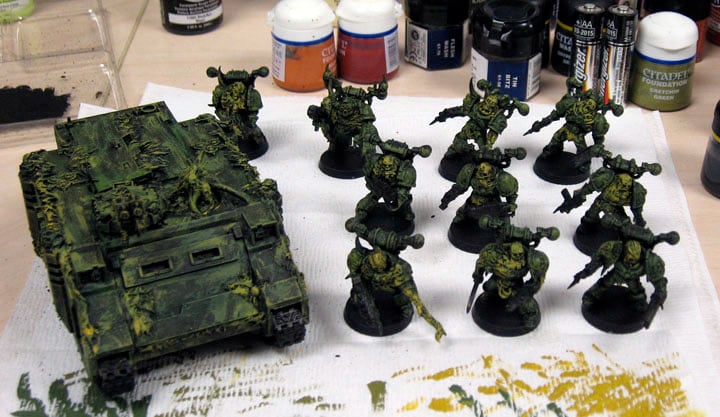
Step 5
I used the Sepia wash on the models in order to try and pull the recesses darker and create more shades of the model. Washes are great, because they double the amount of colors on the model with one swipe. Lets say you have 3 layers of green. An ink or a wash, will create 3 new shades based on those 3 greens. The wash/ink will darken each color, thus creating a new color. The old colors will still be there, maybe not as bright as before, but they will be there.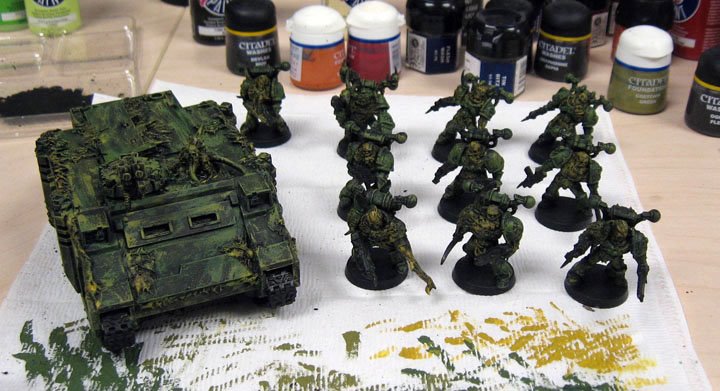
Step 6
Here I added tin bitz as the base color for the metal. Tin bitz works great as a beginning rust color. It is dark enough and has enough of a purple in it to help with any rust colors you want to add in later. IE Flesh Wash ink and anything else.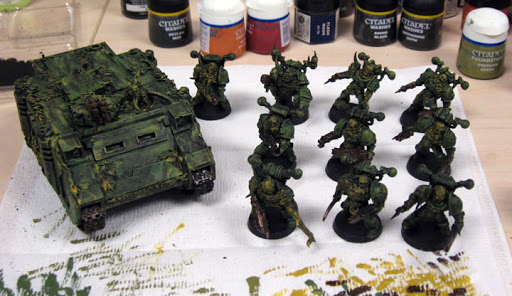
Step 7
Here is where things start to look like my normal minis. My tried and true, super cheap Antique White dry brush. I like the cheap paint, because the amount of pigment is very light, thus it allows me more control over the drybrushing and overall detail work. Antique white is the same color as bleached bone, so you can use that as well. I use the models texture and forms that were already created, to gently put a lightened layer of white on top, to highlight the model.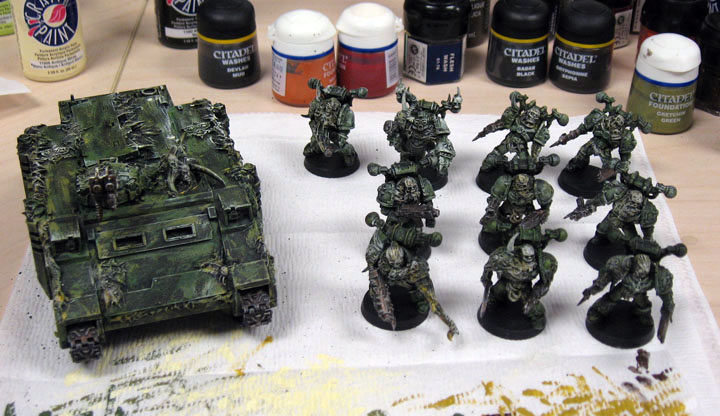
Step 8
Here I add detail work, such as a new highlight color to break up the monotony of the form. I picked red, due to the fact a lot of my army has red shoulder pads, and it helps keep it a part of the Chaos Undivided theme that I want to play with. I start with a foundation paint Mechrite Red, go to a Blood Red from there, and then end with a small bit of drybrushing of Fiery Orange.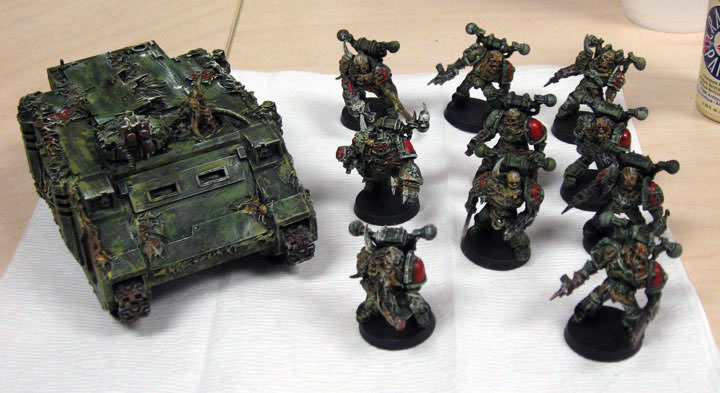
Step 9
Almost finished, here I add a bit of Flesh Ink to the zombie bits and red parts of the armor. This brings down the color, and gives another grimey shade to the flesh. It also breaks it from the armor more and helps make it look like the armor and flesh parts are leaking some kind of brown, brackish liquid. If you put Boltgun Metal on your metal parts, using the flesh ink on it, will create a rust type of effect that looks pretty good. You can see this on my Ork Nob Bikers.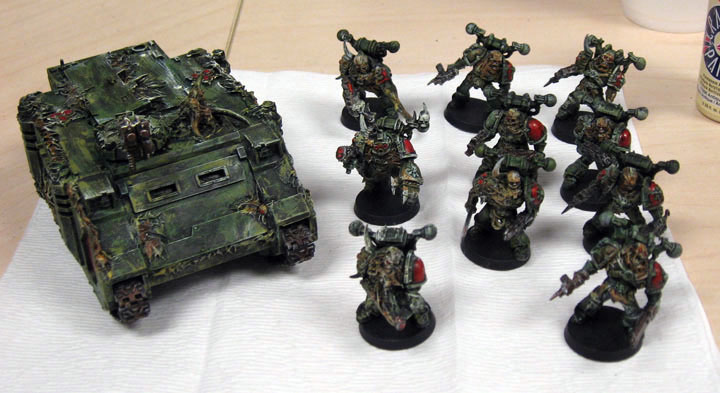
Step 10
Here there are finished, after putting in one more layer of Antique white/Bleached Bone on the flesh parts and basing the models. And I used a fine point Sharpie pen in order to create lines of black in parts of the armor. This will help it stand out more and give a nice bit of contrast to the model. Thanks to Bigred for the tip on this.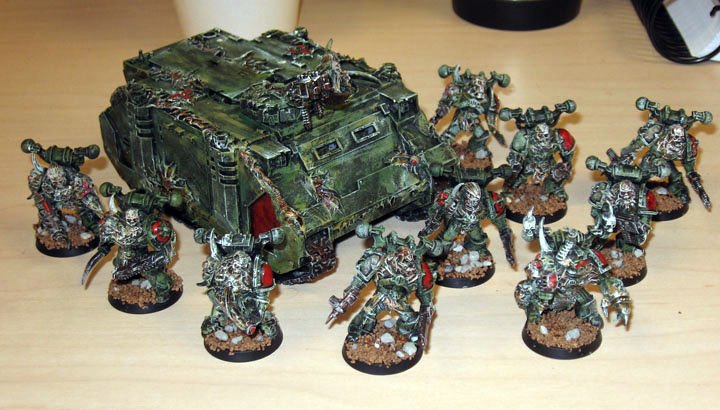
If I did this at home, and not at work, most likely this would have been a 2 hour job at most. If you do models in batches of 10, most of the time you can finish the last model and the first model you started should be dry by now. But yeah, there you go, a nice table quality squad in 2 hours. Hell if you had 20 models you could most likely finish them in 3 hours or so.
~Yes, I know…more Death Guard. But the basic drybrushing with tight detail added in last is easy to replicate across a ton of different colors and models. This technique lends itself well to CSMs, Orks, Tyranids, Necrons, IG, and many more. While I wouldn’t go for such a rough look for Eldar, almost any army out there that needs to look like its not factory fresh or parade ground polished can get from your hobby desk to the tabletop in record time with these methods. Lets hear it for Goatbay, and by all means go check out his blog for even more of his techniques.




